‘They were devouring her with their eyes’
Some remarks on the Warsaw experience in the life and work of Helena Modrzejewska
Abstract
This article concerns the Warsaw period in the life and work of Helena Modrzejewska. The years 1869-1876 are the least researched and described period in the entire career of this actress. The article refers to Zbigniew Raszewski’s essay ‘Modrzejewska-warszawianka’ (‘Modrzejewska the Varsavian’), debating the significance of the experience of the Krakow theatre in Modrzejewska’s work. In the light of a factual analysis, he presents the actress as a Drama Artist of Warsaw theatres, posing questions about the evaluation of the experience of working on the Warsaw stage in the context of her career. The methodological framework of the article is an attempt to see the principles of realistic idealism, i.e. the model style of the art of acting in the nineteenth century, not only in the actress’s stage performance, but also in social life and the iconographic material based on Jan Mieczkowski’s photographs.
Keywords: Helena Modrzejewska; 19th century; Krakow theatre; Warsaw theatres; realistic idealism; acting style; nineteenth-century theatre photography; Jan Mieczkowski; code of conduct
Whenever Helena Modrzejewska is mentioned, most people involved in theatre history reach, as by reflex, for Zbigniew Raszewski’s Weryfikacje czarodzieja i inne szkice o teatrze from 1998 and his text ‘Modrzejewska-warszawianka’ (‘Modrzejewska the Varsavian’). It first appeared in Pamiętnik Teatralny in 1996 (pp. 133-143), four years after Raszewski’s death, as one of his last texts.
This small addition to Modrzejewska’s biography, devoted to her Warsaw flats, was sent to Anna Krajewska-Wieczorek, living in Los Angeles, in two parts, on April 2 and May 1, 1992. It stemmed from Krajewska-Wieczorek’s questions concerning Modrzejewska’s stay in Warsaw. In his letter from April 2, a slightly embarrassed Raszewski wrote:
Dear Anna,
A terrible thing happened. My whole reply to your questions about Modrzejewska’s flats […} has proven to be wrong. She never lived at Senatorska Str. It was the film1 that put her there, and I, a miserable parochial schoolmaster was deceived by it. […] In order to atone, at least in part, I have written an article for you. Especially for you. […]
In the letter accompanying the second part, containing additional remarks and further clarification, sent four weeks later, on May 1, 1992, Zbigniew Raszewski reacted to the proposal of a film about Warsaw in the years 1869-1876, i.e. the years when Modrzejewska lived there permanently. The film was to feature Raszewski as a guide to Warsaw from that period.
In the summer I’ll try to look for photos of the four streets in question from before 1944. Maybe I could even find some from the 19th century. The station, the town hall, the theatre, the Saxon Garden, the Alleys. Perhaps I will write a short introduction. Can the text in the street be improvised? Will it be audible in the traffic?
During her stay in Warsaw, Anna Krajewska-Wieczorek recorded Zbigniew Raszewski’s narrative, but ultimately the film never came into being (Raszewski, 1996, p. 133).
The above was a fragment of the introduction by the editors of Pamiętnik Teatralny. It is uncertain if the recorded material still exists, but we know that this story gave rise to a text which begins as follows:
The title of this sketch sounds provocative. Modrzejewska was a Cracovian, body and soul. Her art can also be said to have been born in Krakow. No reasonable person would deny it.
However, the problem of Modrzejewska in Warsaw prevails. The city received so much from her that it could not possibly deny her, even if it wanted to. She also owed much to Warsaw; it was the city that gave her acting career a countrywide renown (Raszewski, 1996, p. 134).
In the following paragraphs Raszewski expresses his surprise concerning the lack of any books on Modrzejewska’s links to Warsaw and the course of her travels. We still lack such publications2, but in November 2020 students from the Theatre Studies Student Research Group at the Theatre Academy in Warsaw organised the conference ‘Fenomen. Helena Modrzejewska’ (‘Helena Modrzejewska. The Phenomenon’), bringing back the issue of Modrzejewska in Warsaw.
Indeed, there is a problem with recognising the Warsaw theatre experience in the work of ‘a Krakow resident, body and soul’. Modrzejewska is normally discussed through the focus of Krakow, and then her spectacular career in the United States. Her acting craft, as noted by Raszewski, is usually associated with her stage experience in Krakow. Narodowy Stary Teatr im. Heleny Modrzejewskiej (the Helena Modrzejewska National Stary Theatre) in Krakow sealed her links to the theatre of her home city. In this article I will not be able to exhaust a subject as broad as the Warsaw period of Modrzejewska’s life, but I would like to share a few remarks which could prove useful for future research. I also intend to be a bit ‘unreasonable’.
Dates and numbers
I decided to start by looking at dates and numbers3. Modrzejewska’s stage career took place between two dates: July 1961, her debut in Bochnia, and March 1907, when she finished her last, 26th American tour. These two dates, the beginning and the end, lacking specific days, are very mysterious. We know little about the debut of 21-year-old Helena Misel, who took the stage name Modrzejewska in order to appear on a provisional stage in a small Galician town. We do not know the place and exact date of the last performance by Helena Modjeska, 77 years old at that time, regarded as a great star on two continents. There are two alternative dates we could accept for the beginning and ending of her career: October 7, 1865 was the date of her debut in Krakow, on the stage of what is now Narodowy Stary Teatr im. Heleny Modrzejewskiej (the Helena Modrzejewska National Stary Theatre) in Krakow, and May 2, 1905 is when the famous testimonial took place at the Metropolitan Opera House in New York, a homage and farewell to the great American actress applauded by an audience of four thousand. Both events are very well documented, and it is easy to find their traces in reviews, memoirs, posters and photographs. I chose the first version, looking at the actress’ career between 1861 and 1907. In all these years she had only a year’s break, between June 1876, when she left Warsaw, and August 1877, when she performed for the first time in front of an American audience.
These forty-five years of her stage career can be divided into several shorter periods. The first four years (1861-1865) of work on provincial stages in Galicia, including a short period of working as a vaudeville artist at Teatr Skarbkowski (the Skarbek theatre) in Lviv, from November 1862 to February 1863, the following four years (1865-1869) of acting in Krakow, seven years in the state Teatry Warszawskie (Warsaw Theatres; 1869-1876), and thirty years (1877-1907) of work on American stages and in numerous guest performances in Europe, including cities in Polish lands. This brief summary shows that most of Modrzejewska’s professional life, comprising the experience of provincial stages in Galicia, tours of America and guest performances, took the shape of a life on the road – a journey spanning thirty-four years. The seven years spent in Warsaw can seem a brief stage in comparison. Before I get to the Warsaw period, it is worth to focus on 1865 and ask how Teatry Warszawskie were perceived at that time. What could the Warsaw stage been for Modrzejewska from the perspective of Krakow? The actress came to Krakow from Czerniowce probably already in July 1865, with a specific purpose. A new age was beginning in Teatr Krakowski (the Krakow Theatre). The wealthy citizens gathered suitable funds devoted to help the ailing theatre and to give it a new dimension, a vital social significance. At the head of this enterprise stood count Adam Skorupka, who was not a professional, but was well known for his love of theatre. It was decided that a practitioner and expert on theatre should be brought from Warsaw – it was Jan Tomasz Seweryn Jasiński. Then 61 years old, Jasiński had been in well-deserved retirement since 1862. He was greatly respected in the theatre world. Associated with Teatry Warszawskie since 1824, he went through all possible posts – an actor, playwright, translator, director, head of a theatre, a teacher at the School of Drama. He educated almost five hundred students, of whom over a hundred performed in Warsaw, and about seventy in provincial theatres. He shaped the tradition of the Warsaw stage for several decades, respected the most as a director and teacher. Despite his retirement, he still gave advice to actors and directors, close to his beloved stage (Cf. Wanicka, 2007, pp. 132-137). Building his new ensemble at Teatr Krakowski, Jasiński flawlessly recognised Modrzejewska’s talent and, furthermore, gave her the most important emploi of the main protagonist and a suitable range of roles. Modrzejewska, participating in the inauguration of the theatre under new leadership, and the viewers, sitting in the audience of Teatr Krakowski on Sunday, October 1, 1865, could all read the poster, carrying the number 1, and informing that ‘The opening of the spectacles’ would take place under the ‘stage direction’ of Jan Seweryn Jasiński, ‘A. D. [Dramatic Artist], former Director of Teatry Warszawskie’.
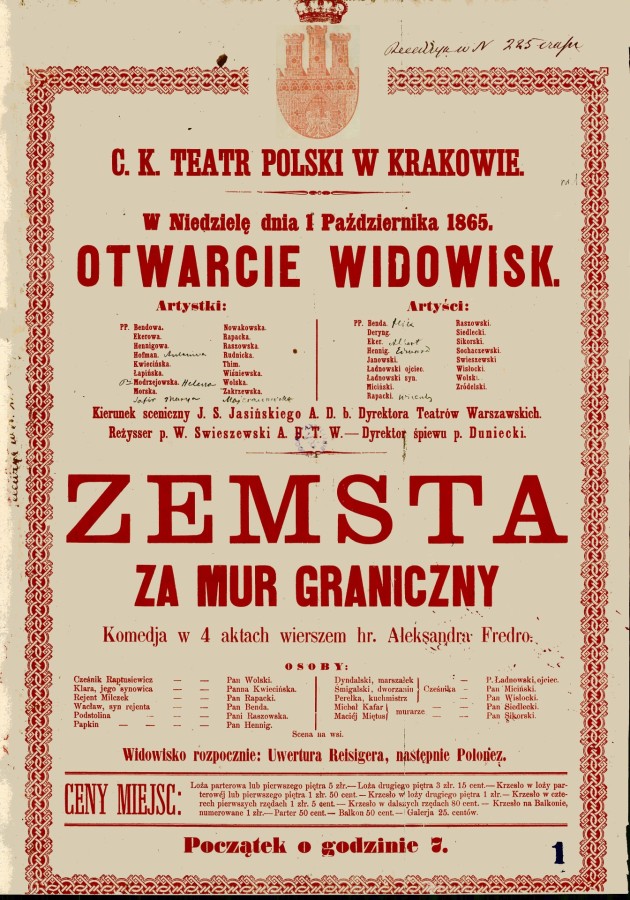
poster of Teatr Krakowski (the Krakow Theatre), October 1, 1865; CBN Polona
A similar abbreviation was used with the name of the director Władysław Świeszewski ‘A.D.T.W. [Dramatic Artist of Teatry Warszawskie]’. Emphasising that the artists represent the Warsaw stages added prestige to the event and warranted a new beginning for Teatr Krakowski.
In 1865 Modrzejewska knew that Teatry Warszawskie were the most important place and goal for an actress. She achieved it three years later, on October 4, 1868, starting a series of guest performances, lasting until November 284. On September 13, 1869, she signed a contract as a Dramatic Artist of Teatry Warszawskie and moved to the capital of the Kingdom. During my lecture on Modrzejewska’s life and work I love the moment when I show two photographs, one representing Teatr Krakowski at Szczepański square, and the other – Teatr Wielki (the Grand Theatre) building at Warsaw’s Theatre Square.
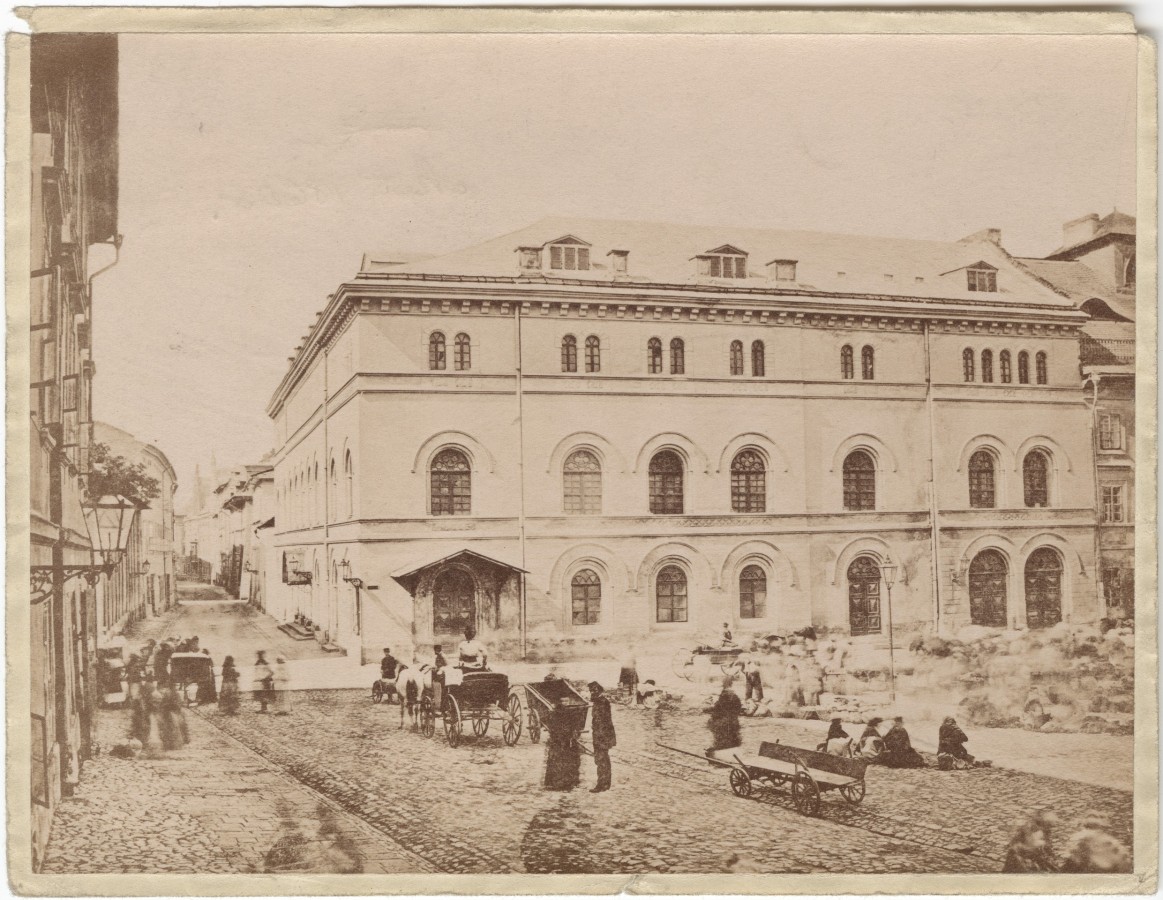
Teatr Krakowski (the Krakow Theatre), ca. 1865
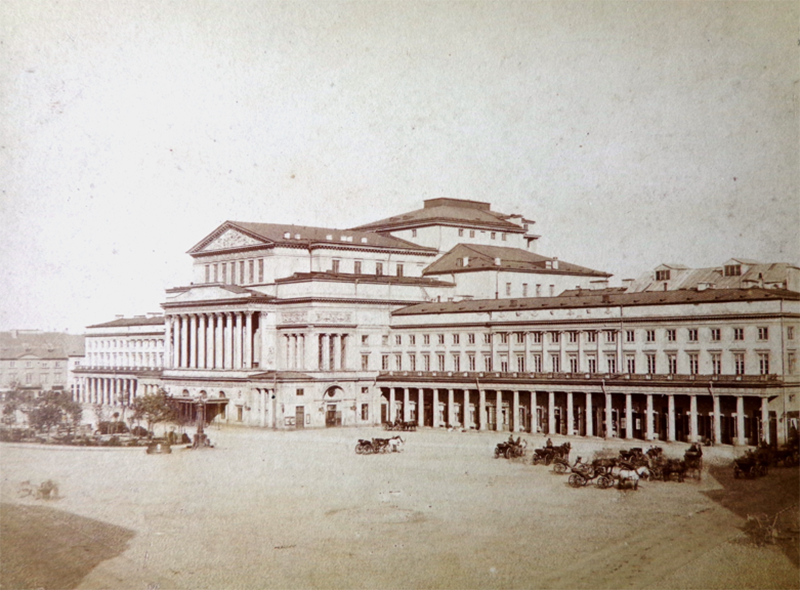
Teatr Wielki (the Grand Theatre) in Warsaw, ca 1870
I wonder what the actress could have felt, standing for the first time before the imposing building on a huge square, which back then was the centre of urban life in Warsaw. The challenge lay not only in the difference in terms of size, so visible in the photographs, but also the significance and tradition, never questioned by the people living in the second half of the nineteenth century. Here, I would like to refer to Stanisław Koźmian’s words from 1875, valuable on many levels. Koźmian started his work in the theatre without any practical experience. He came there from the world of politics and took his post of the artistic director over from Jasiński, who, after completing his work in Krakow, returned home, to Warsaw, in January 1866. Koźmian’s independent directorship began only in 1871, gradually shaping a new age in the history of Teatr Krakowski. Koźmian valued the strength of the tradition of the Warsaw stage, which he saw in the continuation of directorial thought and the structure of the work on performances, enabling the development of the actors’ talents. This tradition continued since the times of
Bogusławski, Osiński, to Jasiński, a good theatre director and informer, Królikowski, Rychter, and Chęciński, who directed performances. This tradition has served, at least until now, to look conscientiously, seriously, sometimes even pedantically, at the duties of the actor and the theatre. Hence the great exactness not only in learning, but also studying roles; a great number of rehearsals, usually good and very thorough (Koźmian, 1959, p. 308).
The growing legend of Koźmian’s age (he led the theatre until 1885) overshadowed the beginnings of Teatr Krakowski in 1865. However, when researching Modrzejewska’s life and work, it is necessary to remember that her work in Krakow happened during the first seasons of a nascent theatre, which would become associated with the legendary director and the ‘Krakow school’ (also called the ‘Koźmian school’) only later, in the 1880s and 1890s. In 1903, Karol Chłapowski wrote a letter to Feliks Koneczny, pointing out the inaccuracies in the latter’s biographical article on Modrzejewska. Chłapowski emphasised that Jasiński was ‘Ms Modrzejewska’s first and only teacher and supervisor in her dramatic profession,’ and added:
It is peculiar than in many mentions of the great age of Teatr Krakowski in the years 1865-1869, when this stage shone with such exceptional brilliance, one so rarely encounters the name of the Director J. S. Jasiński. It is true that good fortune gave the theatre many young talents with a great zeal for work, it is true that count Skorupka as the organiser, and Mr Koźmian as an artistic instructor (specialising in modern plays) have contributed greatly to the development of the organisation – but the most important credit goes to Jasiński, who set the whole machine in motion and put it on the right track – gave suitable ranges to particular actors – and, in a manner of speaking, set the first foundation for the tradition of Krakow theatre (Chłapowski, 2015, p. 481).
After Jasiński returned home, the director and the actress wrote letters to each other, and when Modrzejewska arrived in Warsaw, their friendship continued, later also in epistolary form. In her letters from America Modrzejewska addressed her former director as ‘Dear Father’ or ‘Daddy’ (Cf. Jędrzejczyk 2020). Being Jasiński’s student put Modrzejewska, who never finished the School of Drama in Warsaw (unlike many of her peers in the Warsaw theatre), among his famous pupils – Dramatic Artists of Teatry Warszawskie.
Coming back to the numbers – Modrzejewska became a Dramatic Artist of Teatry Warszawskie, as has already been stated, on September 13, 1869, and worked in the drama and comedy ensemble until June 21, 1876, when she gave her farewell performance on the stage of Teatr Letni (the Summer Theatre)5. How can the seven-year-long Warsaw period be judged in the context of her entire career? Thanks to Józef Szczublewski, who summed up all of her performances, we can state the following. ‘The tally of her performances shows that she worked the most in Warsaw, giving almost 740 performances. Following these: New York (with Brooklyn) 520, Krakow 390 […]’ (Szczublewski, 1975, p. 668). 740 performances in Warsaw is over two hundred more than the performances in ‘Modrzejewska’s cities’ of New York and Krakow. How should we understand these numbers, how should we read them? The large number of performances at Teatry Warszawskie are evidence of the particularities of this stage and its traditions. Referring to Koźmian’s words, quoted above, the Warsaw stage gave the artists a long time for work on the role, followed by numerous opportunities to perform the same role. This principle is easy to grasp when comparing Modrzejewska’s first seasons at Teatr Krakowski and Teatry Warszawskie. In Krakow, from October 1865 until July 1866 (i.e. including guest performances of Teatr Krakowski in Poznań), she had to prepare forty-two new roles, and in her first season in Warsaw, from September 1869 to March 1870 only… four. Additionally, she repeated five roles, including Shakespeare’s Juliet, which she had already tried in Poznań (in a different translation). Working on this role for the Warsaw stage, she had time to work on it, and an opportunity to put it in her repertoire for much longer. It has to be noted that the audiences watched Modrzejewska’s Juliet in Poznań (in guest performances) only twice, while in Warsaw, only in the first season, 1869/70, she gave nineteen performances. Another good example of such a comparison is Ophelia, Modrzejewska’s legendary role from Teatr Krakowski. It has to be remembered, however, that as an actress in Krakow, she performed it… three times in the 1867/1868 season, including an extra time during the guest appearances in Poznań. At Teatry Warszawskie, on the other hand, she performed it twelve times during the premiere season of 1870/1871, and thirty-five times altogether until 1876. It was on the Warsaw stage that her famous roles developed, refined in every detail and then tested in numerous performances, often entering the actress’ stable repertoire, repeated during her American tours and numerous guest appearances in Europe. Conscientious work on the role had been a tradition of the Warsaw stage long before she came there and long after she left. It was a foundation for the great acting talents of the age of the great stars, such as Agnieszka Truskolaska, Józefa Ledóchowska, Leontyna Halpertowa, Ignacy Werowski, Wojciech Piasecki, Alojzy Żółkowski, Jan Królikowski, Wiktoryna Bakałowiczowa and many others. Since 1869 – also Helena Modrzejewska, and numerous actors and actresses after her.
‘The artist should regard nature from the beautiful side’
Researching the ensemble of Teatry Warszawskie under the leadership of Sergei Mukhanov (1868-1880) I came to the following conclusions about the characteristics of the style of the acting craft, including Modrzejewska’s work. I wrote that the style
Could not be credited to the head of Teatry Warszawskie or the newly arrived actors of the Krakow and Lviv theatres, but stemmed from a long tradition and respected standards. The greatness of Modrzejewska’s acting lay not in her innovation, but in a perfect realisation of requirements. The presence of a continuing line in Modrzejewska’s art is emphasised by the words of Leontyna Halpertowa who was reported to have said ‘She has started where I have finished’ after Modrzejewska’s performance in the role of Adrianne [in 1868] (Wanicka, 2011, p. 203).
Modrzejewska must have been very familiar with Teoria sztuki dramatycznej (The Theory of Dramatic Art) by her teacher and ‘father’ Jan Jasiński, a textbook finished in 1865, stemming from years of his teaching and directing experience. Nineteenth-century acting was based on the principle of realistic idealism, explained and described recently by Dariusz Kosiński (Cf. Kosiński, 2003; Kosiński, 2005). Realistic idealism was expressed in the following fragment from Teoria sztuki dramatycznej:
The whole world is the actor’s school, a world in which all passions, all states, all characters are in motion; however, because most of the patterns lack nobility and refinement, the artist should enlighten their choices with science. It is not enough to wear a costume according to nature. One must, additionally, learn to know what is really beautiful, and be able to add suitable colour to the selected patterns, show people with their faults, passions and characters in a light required by art (Jasiński, 2007, p. 207).
These words can be summed up in a specific rule:
The artist should regard nature from the beautiful side, and avoid, even at the expense of the truth, everything that could give rise to disgust instead of pleasure. Nature has to contain everything, because everything is needed and necessary, but on the stage one should present only that which could please and engage (Jasiński, 2007, p. 197).
Thinking about the life and work of Helena Modrzejewska, I have the impression that, as a model disciple of Jasiński, she perfectly realised this rule both in her private life and on the stage. The seven years of her stay in Warsaw can be regarded as a time of a masterful performance of the rules of realistic idealism. I think that the phenomenon of Modrzejewska’s popularity did not consists in her exceptionality, but, on the contrary, in the fact that she was typical, that she followed late nineteenth-century rules of personal life and theatre art, and – it has to be emphasised – she did so brilliantly. I am aware that such a statement needs to be backed by reliable arguments and examples. At this point I would only like to present several leads which could be developed in the future.
Let us return to the scene when the actress stood for the first time in the Theatre Square in Warsaw, looking at the Teatr Wielki building, designed by Antonio Corrazzi. An important detail should be added here: she was probably accompanied by her husband, Karol Chłapowski. They probably looked at the theatre building on September 16, 1868, on the day of their arrival in Warsaw. The flat they rented was nearby, according to Raszewski, at Bielańska street or ‘at the corner of Bielańska and Senatorska streets, or at the corner of Bielańska and the Theatre Square’ (Raszewski, 1998, p. 75). Their wedding had taken place four days earlier, on September 12, at the church of St. Anne in Krakow. A marriage act had been issued for Karol Chałpowski – bachelor, and Helena Jadwiga Misel-Modrzejewska – widow (Cf. Lesiak-Przybysz, Warzecha, 2009, p. 40). ‘Killing’ Gustaw Zimajer with whom she had a son, Rudolf, out of wedlock, was the first consciously shaped change in her biography, according to the principle of ‘avoiding, even at the expense of the truth, everything that could incite disgust instead of pleasure’. At that time Zimajer took care of her seven-year-old son, kidnapped against the actress’ will and returned only several years later, for a considerable sum of money.
In Warsaw Modrzejewska began a new life as a lawful spouse of an aristocrat, descended from the respected Chłapowski family. Today it is difficult to imagine the social advancement which accompanied a marriage with someone from the higher spheres of society in the nineteenth century. Franciszek Siedlecki, the author of the first monograph devoted to Modrzejewska, published in 1927, wrote: ‘Gaining social status through her marriage to the descendant of an old aristocratic family facilitated her later career and helped to realise her artistic plans’ (Siedlecki, 1927, p. 47). The spectacular lifestyle she adopted in Warsaw, made possible by her high wages in a state theatre, as well as yearly charity events and guest performances during the holiday season, suited the lifestyle of the higher spheres of society. It was evidenced by her subsequent flats, which she rented and decorated, a ‘big and expensive’ one at Miodowa street, then at Trębacka, Królewska, and finally Graniczna; the silver tray on which a valet brought the letter from her brother, which, as Raszewski noted, she described to him ‘not without pleasure’ (Raszewski, 1998, p. 84); a private carriage and numerous balls which she attended; an open salon and the famous Tuesdays at Modrzejewska’s, or the elegance of her outfits, which became her trademark sign. It has to be remembered that Modrzejewska represented the most prestigious emploi of the main protagonist and love interest, acting mostly in tragedies, dramas and melodramas on the stage of Teatr Wielki, devoted primarily to opera and ballet performances. It was the most representative hall in the city, with elegant boxes filled with representatives of the aristocracy and rich financiers. The theatre auditoria of the nineteenth century were an excellent reflection of the social structure – the poorest, including workers and students, were crowded in the stalls the ground floor was a space for the intelligentsia, but everybody was looking at the boxes – the people sitting there dictated the rules of fashion and manners. Modrzejewska was one of them, she was a member of the social elite. The immensely popular Kodeks światowy, describing the rules of social life in the second half of the nineteenth century, based on the work of Louise Alquié de Rieupeyroux, which the actress might have read in the original version (it was published in Polish only in 1881) said that: ‘Life consists of a thousand small facts which take on the most varied guises, which cannot be described in detail. Once one knows the world, one should use it to become liked, to assume a position of honour. That should be everybody’s aim’ (Lubowski, 1881, pp. 163-164).
Modrzejewska found herself in a city that particularly valued the form, external beauty, elegant attire, sophisticated movement and charm. The German reporter Fritz Wernick described the Poles he met during his stay in Warsaw as follows:
In Warsaw your taken in from the very beginning by numerous pleasant external traits. Poles are almost without exception well-mannered, they are famous for their politeness and civility, they are brilliant, hospitable and obliging. The ladies’ beauty is not calm, classical or monumental. They are exceptionally attractive due to the harmonious build of their bodies, their lively dark eyes, the delicate colour of their skin as well as innate charm and elegant movement. The men of the Warsaw social elite are characterised by their genuine handsomeness, undiminished by the paleness of their faces and the expression of ennui, contradicted by their lively, shining eyes. Warsaw dresses elegantly, richly and tastefully. Apart from the refined taste, impeccable style and excellent fabrics, the clothes also exhibit a certain finesse, which suits the graceful silhouettes of the people (Wernick, 1970, p. 331).
Most of the features mentioned by Wernick, such as the harmonious build of the body, grace and sophistication of movement were emphasised in almost every recollection of Modrzejewska and in her reviews. It is worth noting that Anna Leo, writing from the perspective of 1929, was well aware that the past ideal would probably not stand the test of time.
I ask myself whether this artist, so much loved during her lifetime […] would enjoy an equally enthusiastic acclaim now. Her classical, regal beauty, her voice, full of pathos, her harmonious gesture, everything that dazzled and charmed us – would for you perhaps be something insincere, rigid, artificial (Leo, 1929, pp. 220-221).
Remembering Modrzejewska’s majestic appearance, contrasting with the style fashionable in the 1920s, she also added: ‘Not to mention the polished metal of the voice, the dignity of the line and movement!’ (Leo, 1929, p. 221).
I saw her at my parents’ home, and in our private salon she seemed to me equally distant, miraculous, regal and inaccessible, as when she played the unfortunate Scottish queen. Each movement she made, each pose, was so utterly beautiful that it was difficult to believe they were spontaneous. She laughed after somebody’s witty remark, and as soon as her low, strangely melodious laughter had sounded, she said: ‘I laughed like the Princess Georges, didn’t I?’ All those around […] devoured her with their eyes. Everybody in Warsaw was in love with her: the young, the old, the artists and the industrialists, the pensioners and the pupils! (Leo, 1929, p. 221)
Modrzejewska realised the same ideal of ‘utter beauty’ – in accordance with Jasiński’s Theory of the Dramatic Art – on the stage. Her acting style emphasised, in accordance with the manners of the time, the need to be liked. Adam Grzymała-Siedlecki noted an interesting remark made by Karol Estreicher: ‘She loves getting on the stage when she is certain the audience will fall in love with her’ (Grzymała-Siedlecki, 1957, p. 83). When searching for the secret of Modrzejewska’s acting, Franciszek Siedlecki astutely began by quoting her own comment, showing her attitude towards the characters she represented.
‘The leading note, which dominated all else when apprehending all the characters I create, has been the love of humanity, and a continuing effort to bring to light the better sides of the characters, those which could redeem their faults and weaknesses.’
In this sentence, written at the end of her life, Modrzejewska revealed the whole secret of her acting art. She had a spirit glowing with love, and out of this love created artistic form. Some called it her innate charm, others – charm emanating from her person; two generations listened attentively to her voice, looking at the harmonious movements of her figure and her controlled gestures, and left the temple of art better, nobler, as if reborn by means of her art (Siedlecki, 1927, p. 117).
It has to be emphasised that although Modrzejewska belonged to an age which valued the word and the sound of the human voice, the strength of her talent lay in her ability to work with the visual form. The author of Świat aktorski moich czasów wrote: ‘As a theatre artist she felt the viewers see more than they hear, and the true inclination of her talent preferred to look for visual communication with the spectators’ (Grzymała-Siedlecki, 1957, p. 87). This sense in Modrzejewska’s acting can be traced throughout her career, but I think the Warsaw period was particularly important. It was here, on the stage of Teatr Wielki, with mostly aristocrats in the audience, she regularly encountered viewers sensitive to the beauty of external form. In Warsaw she also met an artist capable of recording in photography the beauty and charm of the actress ‘devoured with eyes’ in life and on the stage.
It was Jan Mieczkowski, working in Warsaw in the second half of the nineteenth century. Between 1861 and 1880 he owned the biggest and most fashionable photographic studio in the city, situated at 5, Miodowa street (the palace of the bishop of Krakow).
It was the first studio in Warsaw with a well-equipped atelier and waiting rooms, and an iron photographic gazebo. Mieczkowski also had a great shop with chemicals and photographic equipment, a training centre for photographers, and a framing and bookbinding workshop (Garztecki, 1975, p. 728).
The scale of the enterprise can also be seen in the number of employees, about twenty. The photographer’s fame went beyond Warsaw, ‘he sent his works to many international exhibitions in cities such as London (1862, 1867), Moscow, Vienna (1873) and Philadelphia (1876), as well as Paris, at least three times (1864, 1867, 1870)’ (Grąbczewska, 2009, p. 82). It is no wonder that this became Modrzejewska’s favourite photographic studio. Mieczkowski was, above all, a respected portrait photographer. In 1868 he introduced photo negative retouching, as the first one in Poland. In accordance with the rules of the time, through careful posing and excellent use of lighting, he could bring to the fore the beauty of the model. All his photos of Modrzejewska in her famous Warsaw roles, such as Adrianne Lecouvreur, Delilah, Donna Diana, Frou-frou, Ophelia or Cleopatra6 can serve as material evidence accompanying the recollections and reviews, emphasising the grace and beauty of each pose, the extraordinary ability to create harmonious images, remaining in the audience’s memories.
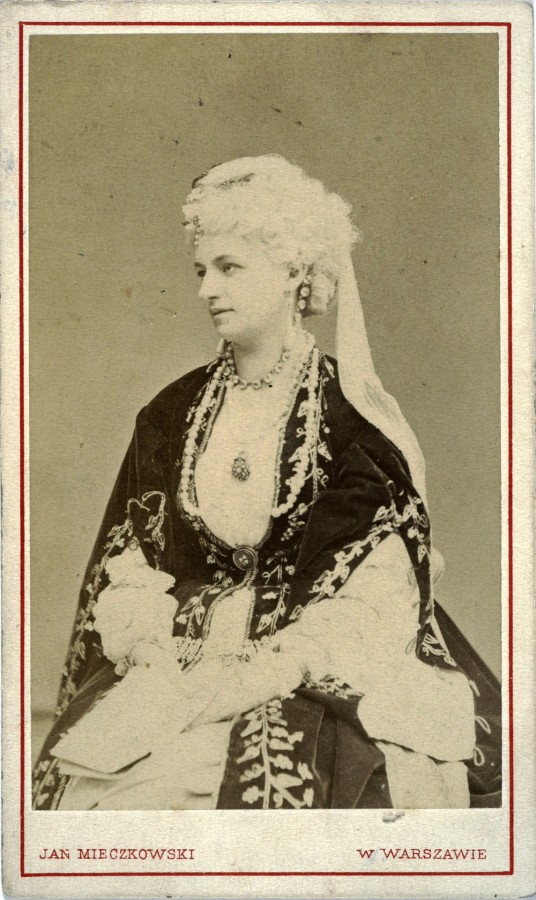
Helena Modrzejewska as the eponymous Adrianne Lecouvreur by E. Scribe and E. Legouvé; photo by Jan Mieczkowski, 1868, CBN Polona
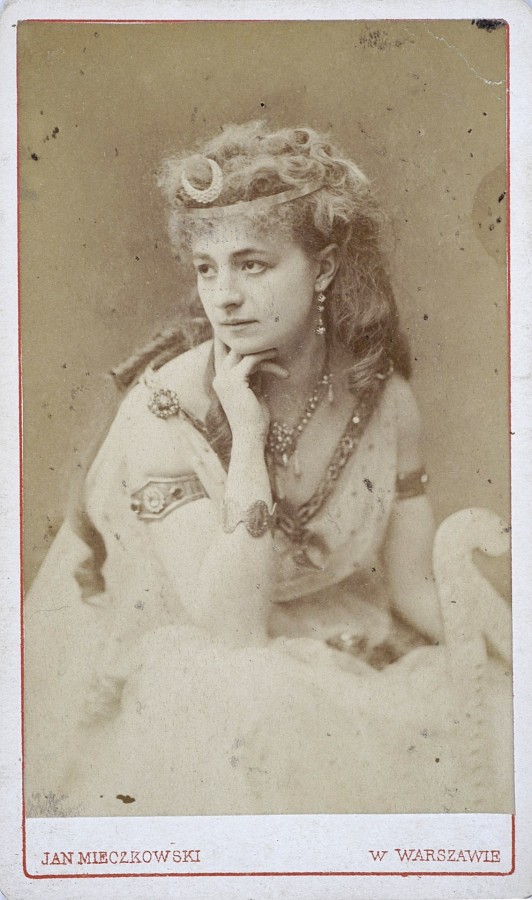
Helena Modrzejewska as the eponymous Donna Diana by A. Moreto; photo by Jan Mieczkowski: 1869, CBN Polona
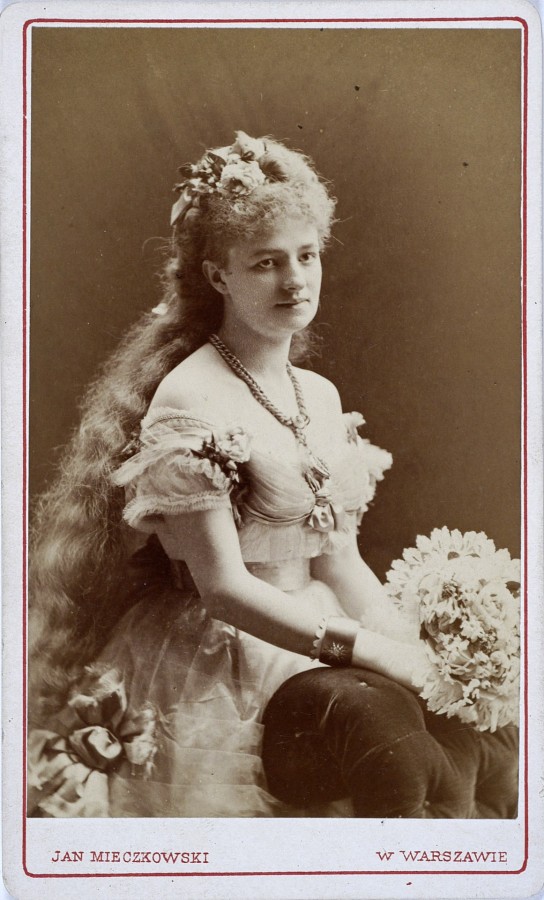
Helena Modrzejewska as Gabriela in Frou-frou by H. Meilhac and L. Halévy; photo by Jan Mieczkowski, 1871, CBN Polona
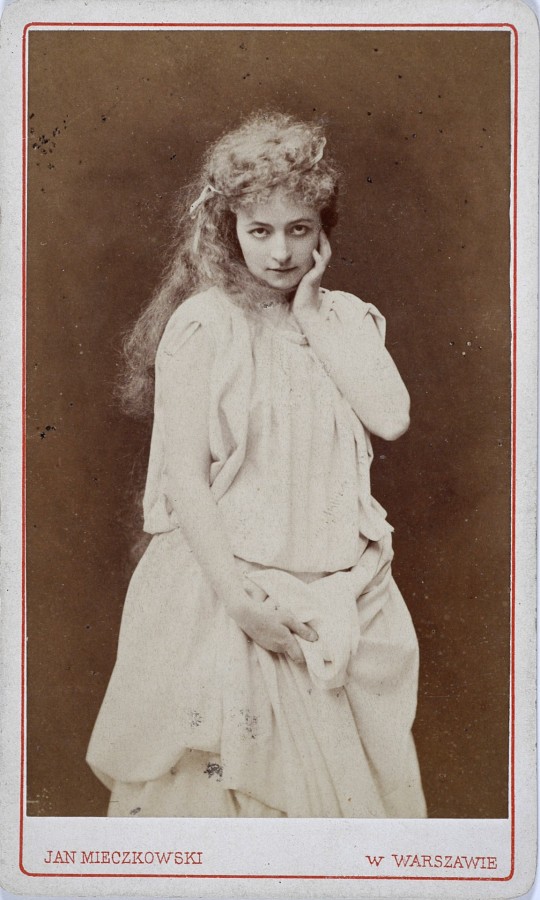
Helena Modrzejewska as Ophelia in Shakespeare’s Hamlet; photo by Jan Mieczkowski, 1871, CBN Polona
This talent was discussed many times by, among others, Wacław Szymanowski, for example in his review of Hamlet, recollecting the scene of Ophelia’s madness: - ‘all of this executed with such incomparable charm, that when Ophelia exited the stage, anyone would want to etch her image in their memory and keep it there forever’ (Szymanowski, 1871, after: Got, Szczublewski, 1958, p. 161). This is how he described the scene of fainting in Adrianne Lecouvreur – ‘When she faints, she seems to float onto the ground, and her figure forms such beautiful shapes that a talented painter facing this model would find nothing he could correct.’ (Szymanowski, 1868, after: Got, Szczublewski, 1958, p. 171). Stanisław Koźmian’s review of Modrzejewska’s guest performance at Teatr Krakowski, where he quoted a letter sent to the editors of Czas, is a good summary of the impression made by the actress. An anonymous reader wrote: ‘I had great pleasure looking at Modrzejwska, I am delighted by her beauty almost as much as by her acting. She is a charming phenomenon and an actress who became an artist in good taste’ (Koźmian, 1879, after: Got, Szczublewski, 1958, p. 171).
Further research on the Warsaw period in Modrzejewska’s life and work should include a thorough analysis of Mieczkowski’s photographs7. Here I will only present one of Modrzejewska’s roles, showing the interpretative possibilities opened by the juxtaposition of reviews and visual material. I was interested in the figure of Yolanda, which was quickly forgotten – the actress never returned to the character. Only Mieczkowski’s photos remained, and they can still charm with the way they grasped the actress’ harmonious movements, her facial expressions, poses and a characteristic charm, emphasised by the soft light, the trademark sign of the great portraitist. Yolanda is the main character in Henrik Hertz’s five-act play King René’s Daughter, performed in Teatr Letni on June 10, 1873, and repeated, which was rare, only two times – on June 10 and 13. The performance was criticised because of the showcase aspect of the role, made for a soloist, barring the development of the less significant roles by the other actors, as well as an improbable plot, lack of action, lengthiness and boredom. The protagonist here is a royal daughter unaware of her own blindness. The play has two crucial points: one, in which Yolanda realises she is blind, and the other when – because of a nascent feeling of love – she is healed.
Władysław Bogusławski wrote in Kurier Warszawski (1873 no. 120)
Ms. Modrzejewska had to carry the burden of the inconsistency of the idea and its clumsy execution. It took brilliant work on the external aspect of the role, and diligent study on what influences our senses directly in the disability of blindness, to distract the viewer from the internal psychological falsehood on which the author built the character of Yolanda.
Delighted by Modrzejewska’s acting, the reviewer from Dziennik Warszawski emphasised that:
An actress herself, no matter how great, will not be enough to recreate such a character; it also has to be a woman with a lofty heart and an excellent mind, one who is able not only to understand, but also feel such exceedingly noble and subtle emotions (Bogusławski, 1873 after Got, Szczublewski, 1958, p. 166).
The role enabled the use of a whole spectrum of poses and gestures in representing the woman’s tragedy and her transformations, which, luckily for us, has been described and photographed.
I have heard talk among the audience, and even among the reviewers present at the performance of King René’s Daughter, that Yolanda is a showcase role. I could agree, on condition, however, that the actress showcasing her abilities will be Ms. Modrzejewska.
Among all the excellent dramatic heroines the artist has presented on the Warsaw stage, Yolanda is perhaps the most beautiful of her creations, and at the same time the most difficult. The blind Yolanda must, in her every movement, in every twitch of her features, be indeed blind even for the most perceptive viewer – otherwise the impact of the role would be immediately lost. Her eyes, with their glassy stare, as if directed not at the world outside, but into the depths of her own spirit, must retain this symbolic expression, and then suddenly, after the return of sight, brighten with all the fire of the soul and the loving heart looking out through them, yet even then they must darken from time to time, still terrified with this altogether too new and hurting impact of the light. This, however, is only one aspect of the difficulty of the role. Beyond it lies another one, contained, in a manner of speaking, in pantomime and pose. Whenever Yolanda is on the stage, she experiences things of a lofty nature: she expresses her feelings for her father, or her idea of nature, or examines her heart, waking up for the first time to the sympathetic sound of a beloved voice […], and finally, all these emotions, doubled by seeing the objects which evoked them, have to illuminate with the colour of life her face, transformed in its psychological expression. Thus, it involves constantly changing facial expressions and constantly changing poses (Bogusławski, 1873 after Got, Szczublewski, 1958, pp. 165-166).
Bogusławski, emphasising the ‘excellent work on the external aspect of the role’ mentioned only one gesture. ‘The gesture with which the actress covers her eyes, as if ashamed at the sight of her beloved, is evidence of a deep artistic insight into the essence of the feeling born in such particular circumstances’ (Kurier Warszawski, 1873 no. 120).
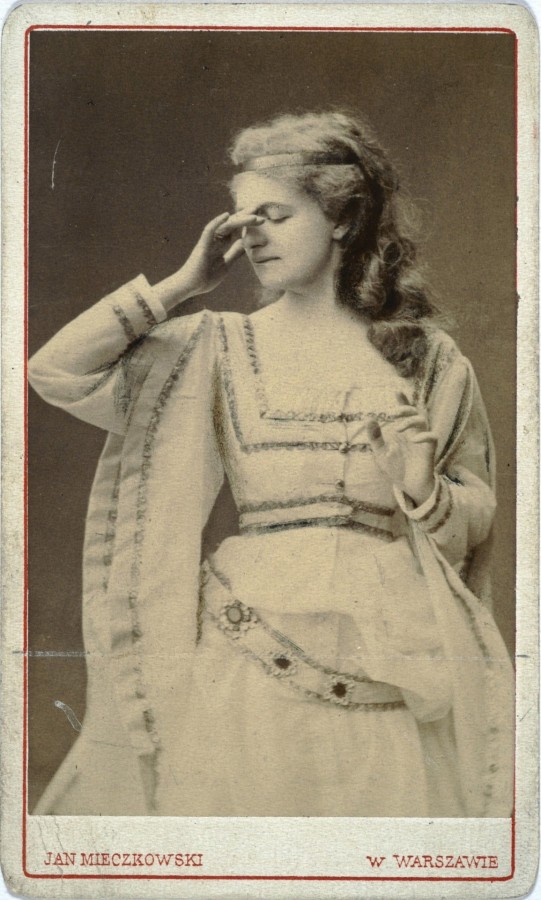
Helena Modrzejewska as Yolanda in King René’s Daughter by H. Hertz; photo by Jan Mieczkowski, 1873, CBN Polona
Mieczkowski’s photographs were used in the first monograph devoted to the artist. Siedlecki gave them titles and described four selected photographs.

The waiting8
Looking into the distance, her deep eyes extended sideways due to a slight closure of the lids, and the mouth, focused, closed into a peaceful line. She raised her left hand to the eyes, as if protecting herself from shafts of light, and her right hand, raised at the breast, expressed waiting in preparation to shake hands as a sign of making peace.
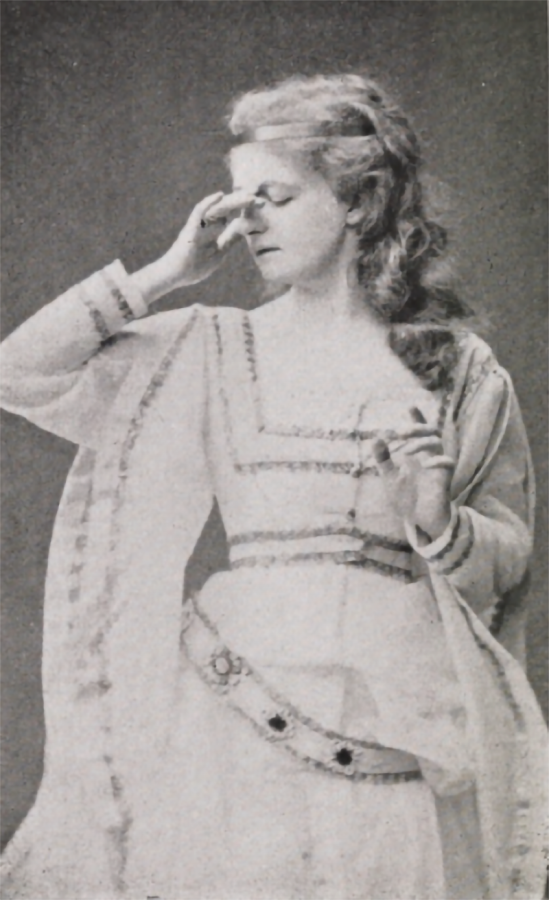
Moved by a message
[…] We learn she has received a message which moved her deeply. She closed her eyes, focused on her inner being, shut her mouth tight so that it became small and narrow. She raised her right hand towards her eyes and wants to avoid crying, and her left hand she raised just slightly, as if she wanted to keep some danger at bay.
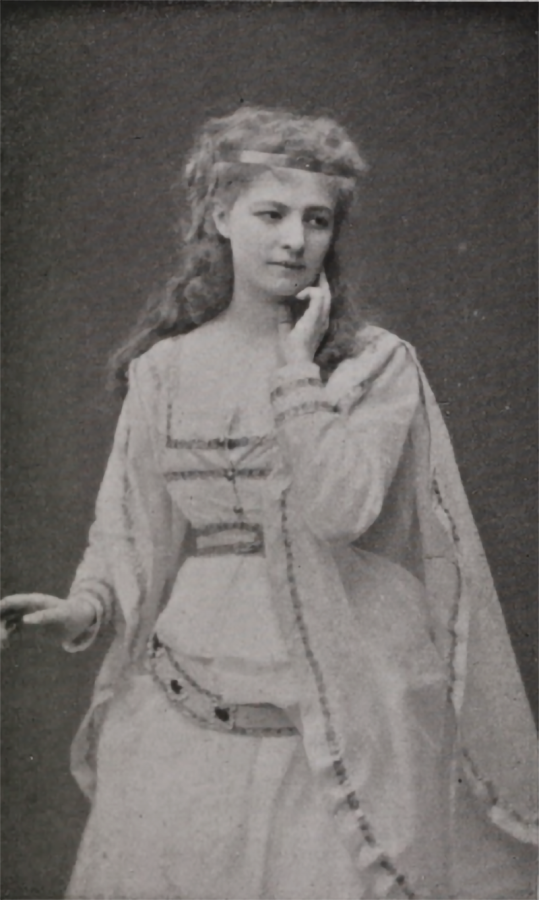
Sadness
[…] Her head is heavy with sad thoughts, she supports it delicately with her left hand. In her eyes – sadness, on her mouth – signs of pain. The smile of contentment has fled, and what remains is a barely visible painful smile, guessing the answer to a question before it was fully uttered. In her eyes, looking with a slight remorse, one can see the resignation of a soul that already understands everything, and forgives. The right hand, in turn, with its palm extended, prepares to bless all that will grow out of the ground before it.
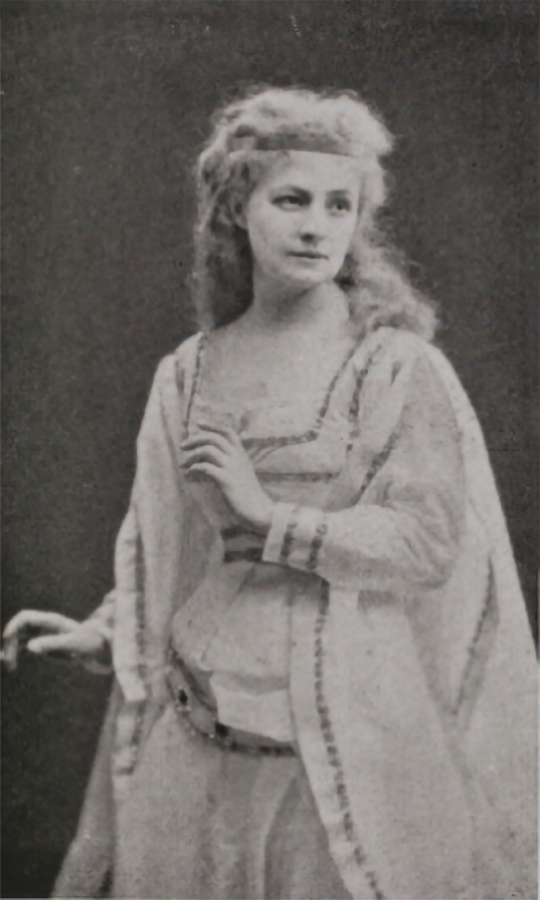
Reproductions of the four photographs by Jan Mieczkowski, showing Helena Modrzejewska as Yolanda in King René’s Daughterby H. Hertz taken from: F. Siedlecki, Helena Modrzejewska, Warsaw 1927.
A painful forgiveness
[…] The soul flies into otherworldly lands filled with longing, the raised eyes look up, towards an escape from suffering. The smile has disappeared altogether and the lips have the expression of an otherworldly serenity. The hands slightly raised and pointing in a direction other than the head, speak of a departure and show a direction. It is a farewell to that which has passed, which happened, and though it was sad and tragic, still, because it did happened, can be regretted, and in this regret can be seen a reproach towards humanity and existence, not fierce and implacable, but forgiving (Siedlecki, 1927, pp. 133-134).
The title of Zbigniew Raszewski’s text ‘Modrzejewska – the Varsovian’ proved to be as accurate as it was provocative. Taking into account the facts and numbers mentioned here, one has to see Modrzejewska as one of the greatest representatives of the “Warsaw school”, brilliantly executing the rules contained in Theory of Dramatic Art by her teacher, Jan Tomasz Seweryn Jasiński. A tableau by Mieczkowski, added as a present for the subscribers of Kurier Poranny I Antrakt in 1877, shows an ensemble that never existed in this form.
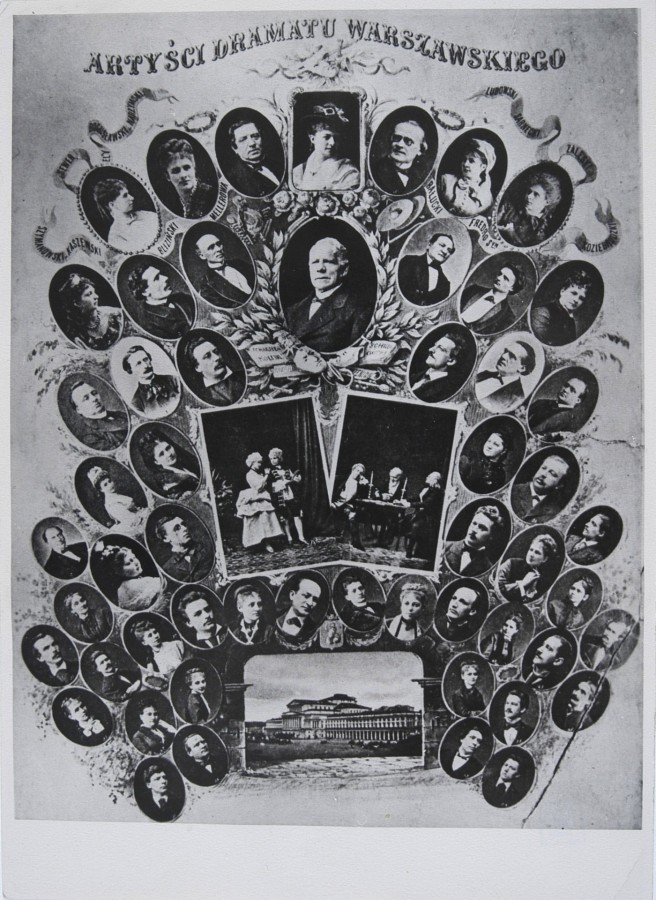
Artists of the Warsaw Drama; photo by Jan Mieczkowski, 1877, CBN Polona
At the time Helena Modrzejewska, in the middle of the bottom row, had already left for America, and Jasiński, in the centre, had been retired for fifteen years. Jasiński’s presence emphasises the tradition of the Warsaw stage, with its most important employ occupied by Helena Modrzejewska, a Dramatic Artist of Teatry Warszawskie. The seven years spent in Warsaw were the most stable period in her career. Warsaw was a space which gave her opportunities to develop her acting talents and lead a social life suiting her ambitions. Researching her masterful execution of the rules of realistic idealism, one can also look for the cracks and fissures, allowing the inconvenient truth. However, I am more and more convinced, perhaps unjustly, that the rule of representing people and the world only from their beautiful sides stemmed from Modrzejewska’s authentic emotions and needs. She was born and died in an era consistent with her internal conviction and it was in this consistency that I would – still thinking on the subject – look for the secret of her talent, as well as her social and theatrical phenomenon.
Translated by Paweł Schreiber
A Polish-language version of the article was originally published in Didaskalia. Gazeta Teatralna 2021 no. 166, DOI: 10.34762/xwms-8c68.

